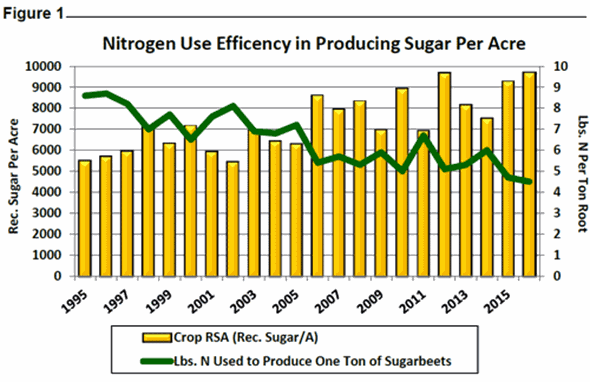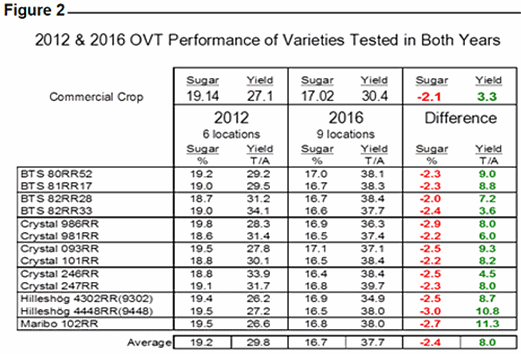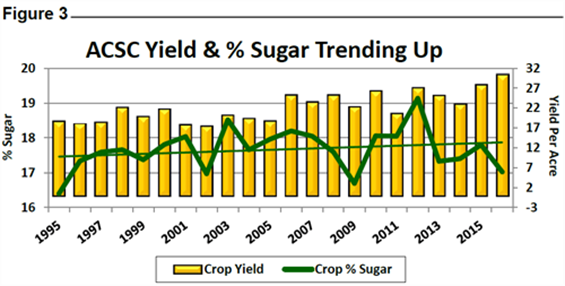604 - Digging into Nitrogen Usage
With assistance from our Ag Information Analyst, we have reviewed nitrogen use via data mining on the subject. Nitrogen use per acre is up, but only slightly on average. In 2012, a high sugar content year at 19.14% for the RRV if you recall, available nitrogen was 138 lbs./acre, in 2016 that number increased to just 141 lbs. per acre (a 2.2% increase in nitrogen available, which is soil tested nitrogen at 0 – 4’ plus applied nitrogen). Generally speaking, we recommend 130 lbs. of actual nitrogen per acre, when using a 4 foot soil test. We recommend 100 lbs. of actual nitrogen available if using a 2 foot soil test.
With increasing sugarbeet root yield and relatively flat nitrogen increases, our per ton of sugarbeet root produced per pound of nitrogen available has decreased from 8.6 pounds of nitrogen per ton in 1995 to 4.5 pounds of nitrogen per ton in 2016, a 48% efficiency increase (Figure 1). This represents a substantial nitrogen use efficiency increase and a positive metric in our sustainability efforts.
Another way to look at this topic is via pounds of sugar produced per pound of nitrogen available. In 1995, 34 pounds of sugar was produced per pound of nitrogen available, in 2016, that value doubled to 69 pounds of sugar produced per pound of nitrogen available, a 202% increase. Our 5-year average (2012 - 2016) is 71 pounds of sugar produced per pound of nitrogen available.

Some Nitrogen Bullet Points from Database Mining:
- The 2012 crop was more consistent across RRV with weather conditions and more uniform up and down the valley vs. comparing the 2015 and 2016 crops
- For the 10-year summary, 141 – 160 lbs. nitrogen available per acre (soil tested N plus N applied) = highest Rev and RSA (with significant acreage)
- For the 5-year summary, 121 – 140 lbs. N per acre = highest Revenue and RSA (Recoverable Sugar/Acre - with significant acreage) but very comparable to 141-160 lbs. N/acre applications...with added freight and nitrogen cost, the economic advantage goes to 121-140 lbs. of N per acre.
- *** We recommend comparing crop information to the past 5 years of production as agronomics, crop protection products, and genetics have changed fairly significantly when comparing to 10 years ago.***
- Exceeding 160 lbs. N/acre, from our records, suggests overall lower quality in terms of lower sucrose content and higher LTM. Our data indicates exceeding 160 lbs. N/acre has not been an advantageous practice overall when considering return on input costs.
- The Crookston District is higher in nitrogen rates applied + available, but about average in lbs. of nitrogen per ton of beets produced because of typically higher yields in that district. This value has decreased nicely with increased yields and a positive for us in terms of sustainability efforts.
- The data mined suggests growers are adjusting nitrogen availability to the longer growing seasons (early spring). Having the ability to adjust nitrogen application in the spring is beneficial and improves nitrogen use efficiency for the growing season.
- 4 foot soil test nitrogen results are somewhat higher in the northern RRV. Overall nitrogen tested in soils, is up from 2012 to 2016. 4 foot soil test Nitrogen available was up from 2015 to 2016, due to much higher than average nitrogen mineralization (warm soils with adequate moisture) and growers responding to longer growing season. These two aspects are plausible explanations for increased total available 4 foot nitrogen tests for the 2016 crop.
- In my opinion, a blanket application of one rate of Nitrogen per acre is not warranted...there are areas in the RRV needing slightly more nitrogen to maximize production (RSA), contact your Agriculturist for local area details, and consult with them for their insight for proper nitrogen rates.
Sugarbeet varietal information:
What a difference a growing season has in influencing the same varieties
There have been questions from last year going into this year in regards to sugarbeet varieties currently available. The concern is that high yielding varieties are taking away from quality and high yields are the wrong way to go in terms of sugar production. The chart below (Figure 2) is a comparison of sugarbeet varieties in the American Crystal Sugar Company Official Variety Trials (ACSC OVT’s) comparing 13 varieties planted in both years (2012 & 2016).
Recall that our 2012 RRV sugarbeet crop (and growing conditions) yielded 27.1 tons per acre, with 19.14% sugar and a 1.30% SLM for a Recoverable Sugar per Acre (RSA) of 9,675 lbs., whereas the 2016 sugarbeet crop yielded 30.4 tons per acre, with 17.02% sugar and a 1.08% SLM and an RSA of 9,698 lbs. You can see similar RSA’s, however with the RSA advantage going to the 2016 crop.
The same 13 varieties grown in each year of these trials in 2016, yielded 8.0 tons per acre more with 2.4% sugar less sugar...these are exceptionally different and significant changes in quality and yield, due to environmental variation. In 2016, environmental conditions were the leading cause of increased nitrogen mineralization, and therefore the largest driver in the decrease of quality and increased root yield. Today’s American Crystal Sugar Company sugarbeet variety options are providing growers with the most talented varieties (in terms of disease resistance, root aphid resistance, sugar content and yield potential) American Crystal Sugar Company has had available (Figure 3), and the sugar produced per acre is testament to this with the 2016 crop setting a Company record of 9,698 lbs. of recoverable sucrose produced per acre.


